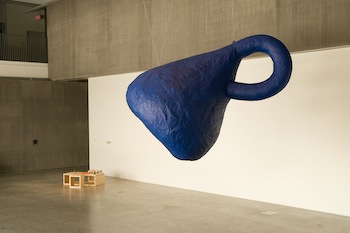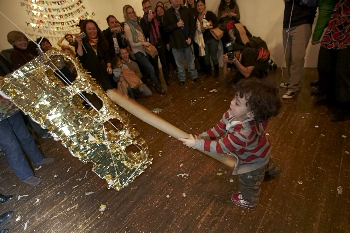The much-talked-about Andy Warhol piñata, created by Jennifer Rubell for last month’s Brooklyn Ball, offered a witty art spin on an old party tradition. Instead of the usual candy contents, this piñata spilled Hostess brand snack cakes, icons of American junk food culture, redolent of Warhol’s work in pop art. Given the amount of art world enthusiasm about the piece, it seems a good moment to look at piñatas as an art form. Rubell is not the first to make clever use of this sweet-filled object. What follows is by no means an exhaustive history of artist’s piñatas, but a look at some recent ones that, similar to Rubell’s, were stuffed with small treats and big concepts.

Mariana Castillo Deball, "Klein bottle piñata" as installed at the Contemporary Art Museum St. Louis, 2009. Paper mâché. Courtesy the artist. Photo: David Ulmer.
Since January, museum audiences in the United States and Europe have been taking whacks at Klein bottle piñata (2009) created by Mariana Castillo Deball for the traveling exhibition For the blind man in the dark room looking for the black cat that isn’t there, organized by the Contemporary Art Museum St. Louis. Hung in austere museum lobbies, Deball’s Piñata looks more like an semi-precious kinetic sculpture than a goodie-filled party piece. Its color and title intimate the intense blue hue developed by French artist Yves Klein, while the shape refers to the “bottle” attributed to nineteenth-century German mathematician Felix Klein. In short, the Klein bottle is a topological surface with no inside or outside. “It’s a container that has no content, or has no possibility of having content,” says the artist. Klein bottle piñata was born out of a lecture-style performance about black boxing and how greater sophistication of knowledge makes technology more cryptic for its users. “For example,” said Deball in a recent video podcast, “everyone has refrigerators, computers, and mobile phones, but nobody knows how actually these devices work. This piñata is a sort of metaphor for [how] cryptic all the objects and the things we use on a daily basis have become.”
Klein Bottle Piñata also relates to the artist’s native Mexico where these “devices,” as she calls them, are mainly used for Christmas and birthday parties. Deball suggests that getting what’s inside is only half the fun. “Sometimes the actual procedure of breaking up the piñata is much more interesting than the toys or objects you can collect…Sometimes breaking it up is the end of the game. You’re not interested any more in the presents or things you are taking out afterward.”

Meg Cranston, "Magical Death" installation, 2002. Paper mâché with color tissue and touches of pastel. Courtesy the artist and The Happy Lion Gallery.
For some artists, stuffing their piñata is not as important as the beating it will take, especially when it’s a self-portrait. From 2002-2007, Los Angeles-based artist Meg Cranston created a series of empty piñatas in her own image. Each piece in the series is titled after the anthropological documentary Magical Death (1973) about the Yanomami people of Brazil who use ritual warfare, or “shamanic drama” to avoid real blood shed. According to Artforum, early in the series Cranston invited visitors to “enact a similar ritual murder on her own pendant form—if they would be willing to pay for the pleasure by buying the work.” Cranston later suggested that no one had taken her up on this masochistic challenge and for this reason she filled her last piñata with candy. “The violence has to occur,” she said, “so the figure (my doppelgänger) can symbolically triumph.” When Jamaica-born artist Dave McKenzie commissioned an effigy of himself as piñata, his “hanging” and “beating” had entirely different connotations. The video Self-Portrait Piñata (2002) documents an event at the Queens Museum of Art in which museum-goers joyously bash McKenzie’s likeness. Candy and fun seem trivial, if not inappropriate, as his dangling lifeless figure begins to conjure America’s history of lynching and other racially charged violence.
New York-based artist Ronny Quevedo sights McKenzie’s piñata as personally memorable. In January, Quevedo and artist Blanka Amezkua invited twenty-three emerging artists to create piñatas for the one-night exhibition and party, Rompe Puesto, at the Bronx River Art Center. (The event’s title loosely translates to “breaking ground.”) At the time, Quevedo and Amezkua were talking about “a lack of community and physical gatherings in the Bronx and among Bronx artists” and thinking of ways to bring people together. Quevedo had been independently thinking about piñatas as “a materially cheap way to make something.” The form is simply paper mâché, wheat and tissue paper (though clay is also an option). Quevedo said in a recent phone interview, “We figured the best thing was to have a party of piñatas and invite the community…We didn’t advertise it as a family event, but a lot of kids showed up.”
Kid-friendly contents could be found in a bust of Christopher Columbus filled with gold chocolate coins, and in Quevedo’s gold four-finger ring (pictured above) that on one side bore the name of Inca king Atahualpa. Inside were ring pops. Some piñatas were better left to the grown-ups. Risa Puno, for example, created a fully functional disco ball that, along with a DJ, set the mood for the evening (see video). The last to be broken, it contained all the provisions one might need for an after-party, so to speak: mini bottles of liquor, condoms, pregnancy tests, Advil, and then some. Other piñatas gifted custom-made t-shirts, small sculptures, and photocopies of an artist’s drawings.
Along with community and creative process, Quevedo took a personal interest in the history of piñatas. “Realizing that, at one point, they were used to coax Native Americans in South and North America into Christianity,” he said, “was a big influence for me.” The seven-pointed star piñata, almost as common as cartoon figures today, is a relic of such religious manipulation. Early missionaries supposedly used it to represent the seven deadly sins, which required only “blind” faith to destroy.

Aaron Krach, "Indestructible Object", 2009. Pinata, copper leaf, chocolate, Plexi. 30 x 18 x 8 inches. Edition: 1/3. Courtesy the artist and DCKT.
The ceremonial destruction of an artist’s piñata typically corresponds with an exhibition’s closing. Aaron Krach’s copperleaf donkey, Indestructible Object (2009), was instead smashed at the grand opening of Invisible Exports gallery last year. The crushed shell was displayed in plexi for the remainder of the show. Krach is largely interested in objects you can’t keep. Or if you keep it, “you have to recognize that it changes.” He explains: “A scratched lottery ticket that doesn’t offer a prize. Is it useless? It’s still the same piece of paper on an elemental level. Same with a piñata. It’s still sculptural and interesting, but it’s been ‘destroyed’ in most viewers’ eyes. I want to subvert that.”
Krach grew up surrounded by Mexican and Mexican-American culture in Los Angeles and says, “Piñatas were more common at birthday parties than games like Pin the Tail on the Donkey.” To a degree, he resents those affairs.”When you’re a kid and you go to a birthday party, bust the piñata, and all you get are hard candies, maybe peppermints or butterscotch balls, you’re angry!” And so, Krach fills his piñatas (there has been more than one) with expensive imported chocolate truffles in a few different flavors. From the shell of the piñata down to the candy, participants continually pull back layers. “Also very important,” he says, “is that they are wrapped in the most beautiful colorful foil. These chocolates are so pretty you don’t want to eat them, but of course that’s just like the piñata. You’ve got to open them in order to really enjoy them.”






Pingback: Smash Art: Help us build piñatas for our performance | Flagler Arts Space
Pingback: piñata « these delights